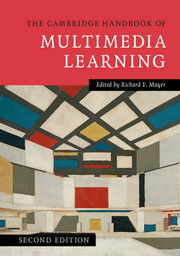Book contents
- The Cambridge Handbook of Multimedia Learning
- The Cambridge Handbook of Multimedia Learning
- Copyright page
- Contents
- Contributors
- Preface
- Acknowledgments
- 1 Introduction to Multimedia Learning
- Part I Theoretical Foundations
- 2 Implications of Cognitive Load Theory for Multimedia Learning
- 3 Cognitive Theory of Multimedia Learning
- 4 Integrated Model of Text and Picture Comprehension
- 5 The Four-Component Instructional Design Model: Multimedia Principles in Environments for Complex Learning
- Part II Basic Principles of Multimedia Learning
- Part III Advanced Principles of Multimedia Learning
- Part IV Multimedia Learning of Cognitive Processes
- Part V Multimedia Learning in Advanced Computer-Based Contexts
- Author Index
- Subject Index
5 - The Four-Component Instructional Design Model: Multimedia Principles in Environments for Complex Learning
from Part I - Theoretical Foundations
Published online by Cambridge University Press: 05 August 2014
- The Cambridge Handbook of Multimedia Learning
- The Cambridge Handbook of Multimedia Learning
- Copyright page
- Contents
- Contributors
- Preface
- Acknowledgments
- 1 Introduction to Multimedia Learning
- Part I Theoretical Foundations
- 2 Implications of Cognitive Load Theory for Multimedia Learning
- 3 Cognitive Theory of Multimedia Learning
- 4 Integrated Model of Text and Picture Comprehension
- 5 The Four-Component Instructional Design Model: Multimedia Principles in Environments for Complex Learning
- Part II Basic Principles of Multimedia Learning
- Part III Advanced Principles of Multimedia Learning
- Part IV Multimedia Learning of Cognitive Processes
- Part V Multimedia Learning in Advanced Computer-Based Contexts
- Author Index
- Subject Index
Summary
The four-component instructional design (4C/ID) model claims that four components are necessary to realize complex learning: (1) learning tasks, (2) supportive information, (3) procedural information, and (4) part-task practice. This chapter discusses the use of the model to design multimedia learning environments in which instruction is controlled by the system, the learner, or both; 22 multimedia principles are related to each of the four components and instructional control. Students may work on learning tasks in computer-simulated task environments such as virtual reality environments, serious games, and high-fidelity simulators, where relevant multimedia principles primarily facilitate a process of inductive learning; they may study, share, and discuss supportive information in hypermedia, microworlds, and social media, where principles facilitate a process of elaboration and mindful abstraction; they may consult procedural information using mobile apps, augmented reality environments, and online help systems, where principles facilitate a process of knowledge compilation; and, finally, they may be involved in part-task practice with drill-and-practice computer-based/app-based training programs and part-task trainers, where principles facilitate a process of psychological strengthening. Instructional control can be realized by adaptive multimedia systems, but electronic development portfolios can be helpful when learners are given partial or full control. Research implications and limitations of the presented framework are discussed.
Keywords
- Type
- Chapter
- Information
- The Cambridge Handbook of Multimedia Learning , pp. 104 - 148Publisher: Cambridge University PressPrint publication year: 2014
- 45
- Cited by

